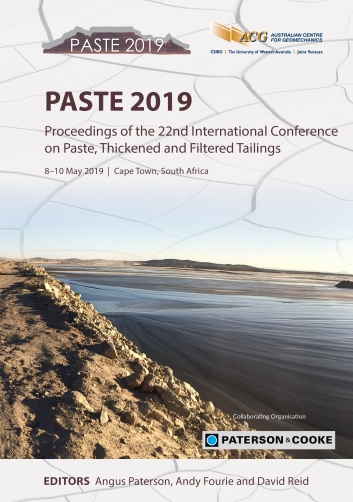An integrated approach to cost comparisons of different tailings management options

|
Authors: Carneiro, A; Fourie, AB |
DOI https://doi.org/10.36487/ACG_rep/1910_05_Carneiro
Cite As:
Carneiro, A & Fourie, AB 2019, 'An integrated approach to cost comparisons of different tailings management options', in AJC Paterson, AB Fourie & D Reid (eds), Paste 2019: Proceedings of the 22nd International Conference on Paste, Thickened and Filtered Tailings, Australian Centre for Geomechanics, Perth, pp. 115-126, https://doi.org/10.36487/ACG_rep/1910_05_Carneiro
Abstract:
There are growing expectations of mining companies to operate in a more sustainable manner, with a strong business case for improving waste management and reducing environmental impacts. As the stewardship of tailings come under increasing scrutiny, decision-makers are urged to adopt a robust approach to the selection of a tailings management strategy that encompasses design for closure, and leading practices to lower the risk of catastrophic dam failures, optimise the use of resources, and mitigate environmental impacts on climate change. An integrated analysis, considering economic, environmental, social, and risk aspects of the operation can therefore provide decision-makers with balanced information to ensure the right projects proceed with an optimal business case so that the most cost-effective solution, that does not externalise costs, can be selected. However, literature review revealed that fundamental shortcomings exist within traditional evaluation approaches used for economic comparisons. This paper reports on life cycle cost analyses conducted for comparing various tailings management options under different scenarios. A conceptual case study for the disposal of gold tailings in Western Australia as a slurry, as thickened, or as filtered tailings, was considered. This was done for examining the extent to which potentially hidden costs impact on the total cost of a project. It is suggested that the proposed approach will lead to selection of a tailings management alternative that ensures sound economic, environmental, and social performance is achieved.
Keywords: tailings management, cost comparison, mine closure, life cycle assessment, sustainable mining
References:
Carneiro, A & Fourie, AB 2017, ‘Economic evaluation for the disposal of slurry versus thickened tailings in Western Australia – A case study’, in GW Wilson, DC Sego & NA Beier (eds), Proceedings of the Twenty-first International Conference on Tailings and Mine Waste, University of Alberta Geotechnical Centre, Edmonton, pp. 138–149.
Cummings, J 2014, ‘The mining industry and land rehabilitation in Australia–once were leaders?’, Journal of Cleaner Production, vol. 84, pp. 39–40.
Department of Foreign Affairs and Trade 2016, Leading Practice Sustainable Development Program for the Mining Industry, viewed 1 October 2018,
Department of Mines, Industry Regulation and Safety 2013, Mining Rehabilitation Fund – Guidance, viewed 1 October 2018,
Espinoza, RD & Morris, JWF 2017, ‘Towards sustainable mining (part II): accounting for mine reclamation and post reclamation care liabilities’, Resources Policy, vol. 52, pp. 29–38.
Gluch, P & Baumann, H 2004, ‘The life cycle costing (LCC) approach: a conceptual discussion of its usefulness for environmental decision-making’, Journal of Building and Environment, vol. 39, pp. 571–580.
International Council on Mining and Metals (ICMM) 2015, Sustainable Development Framework: ICMM Principles, viewed
International Council on Mining and Metals (ICMM) 2016, Position statement on preventing catastrophic failure of tailings storage facilities, viewed 1 October 2018,
ISO 2006a, ISO 14040:2006 Environmental Management – Life Cycle Assessment – Principles and Framework,
ISO 2006b, ISO 14044:2006 Environmental Management – Life Cycle Assessment – Requirements and Guidelines,
McPhail, G 2006, Implications of Different Tailings Disposal Options on Future Rehabilitation, viewed 1 October 2018,
PRé Consultants 2019, SimaPro, version 8.5.2.0, computer software, PRé Consultants, Amersfoort, https://simapro.com
Robins, M 2004, Closure of Tailings Facilities: Current Practice Review and Guidelines for Success, viewed 1 October 2018,
World Resources Institute 2013, GHG Mitigation in Australia: An Overview of the Current Policy Landscape, viewed 1 December 2018,
© Copyright 2025, Australian Centre for Geomechanics (ACG), The University of Western Australia. All rights reserved.
View copyright/legal information
Please direct any queries or error reports to repository-acg@uwa.edu.au
View copyright/legal information
Please direct any queries or error reports to repository-acg@uwa.edu.au


